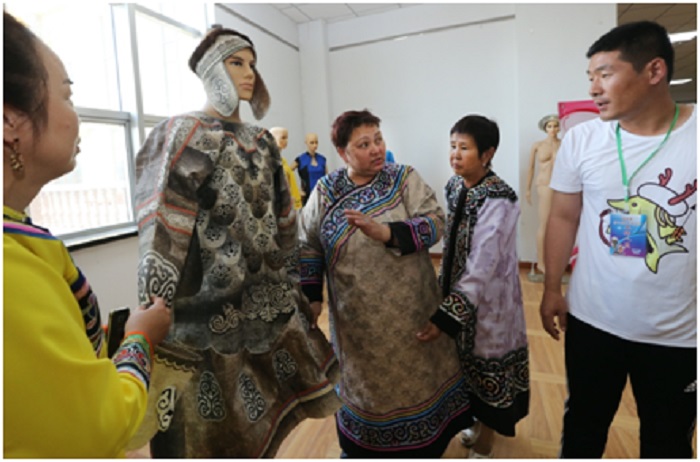



Hezhe people, one of the smallest ethnic minority groups in China, are now embracing prosperity as they keep alive their culture and heritage.
People of Hezhe (which means “people in the east” in the local language) ethnic group in China lived on fishing and hunting for several thousand years and have inhabited areas along the Heilongjiang River, Songhua River and Wusuli River in northeast China.
Jiejinkou Hezhe township in Tongjiang city, northeast China’s Heilongjiang province, is one of the three existing ethnic townships of the Hezhe people in China.
You Wenfeng, a resident in the township as well as an inheritor of the craft of making fish-skin clothes, always introduces the craft to visitors in details passionately. As the only inheritor of the intangible cultural heritage, the woman in her late sixties considers it her mission to bring the traditional skill of Hezhe to more people.
She has lent most of the fish-skin clothes she made to museums for exhibition, and now has two pieces left at home, according to her.
“The skill of making fish-skin clothes has been passed down for generations in our ethnic group,” said You, adding that she learnt the technique from her mother.
Basically all Hezhe women in her mother’s generation could make clothes from fish skin, according to You.
However, as Hezhe people no longer depend on fishing or hunting for their livelihood, fewer people wear fish-skin clothes.
“If too few people can make fish-skin clothes, the traditional technique would become extinct,” You said.
Worrying about the inheriting of the intangible cultural heritage, she started to teach residents in her township the traditional craft. As time went by, people started to visit her from outside the township to learn the skill. She has also been invited to introduce and teach the technique in classes held in cultural promotion centers in Tongjiang city.
Her students include both people of Hezhe ethnic group and Han people who are interested in the fish-skin clothes making technique.
As more and more people, with their ages ranging from 20 to 60, have started to learn about making fish-skin clothes in recent years, the traditional craft of Hezhe has been introduced to various areas of the country.
Liu Lei, a woman of Hezhe ethnic group and also the only deputy of the ethnic group to the National People’s Congress (NPC) of China, has tried to promote the skill of making fish-skin clothes in front of the cameras during the annual sessions of the NPC and the Chinese People’s Political Consultative Conference (CPPCC) National Committee every year since she became a deputy to the NPC in 2008, when she was only 23.
She always attends the important annual sessions, which are normally held at the Great Hall of the People in Beijing, in Hezhe ethnic clothes with fish skin elements, including waistcoats and hats.
During the “two sessions” in 2016, she showed a wallet and accessories made from fish skin in front of reporters, introducing Hezhe people’s special technique to more people.
Hezhe ethnic group has a population of merely 5,000 or so, and the language of Hezhe people has been passed down only by word of mouth because they have no written language, said Liu, who pointed out that many items in the Hezhe ethnic culture that Hezhe people are so proud of are dying out, such as fish-skin clothes and Yimakan storytelling, an oral art in the form of singing and speaking aimed to showcase the history, legends and customs of Hezhe ethnic group.
In the past years, she has submitted many motions concerning the protection and inheriting of Hezhe culture as a deputy to the NPC. “I’m very touched that the central and local governments have both provided strong support in our efforts to preserve our culture by rolling out favorable policies and allocating funds,” Liu noted.
As Hezhe ethnic group doesn’t have its own characters, Yimakan storytelling, which symbolizes the history and culture of the ethnic group, has run into difficulty while being passed down.
In 2006, Yimakan storytelling was listed in the first batch of national-level intangible cultural heritage in China.
Five years later, it was inscribed on the List of Intangible Cultural Heritage in Need of Urgent Safeguarding by the United Nations Educational, Scientific and Cultural Organization (UNESCO).
“At the end of 2012, Jiejinkou Hezhe township established a Yimakan teaching and learning station to explore the traditional culture of Hezhe and invite inheritors of Yimakan and other intangible cultural heritage to give lessons,” Wu Baoli, head of the station, told People’s Daily.
The township has also set up an art troupe to create and perform Yimakan and other song and dance shows of the ethnic group.
“We have seen a growing consensus on protecting and inheriting the culture of Hezhe ethnic group,” said Liu, who believes that preserving the culture of Hezhe people equals sustaining the roots and spirits of the ethnic group.


The Executive and members of the.


The Acting Director, FCT Directorate of.


President Bola Ahmed Tinubu has been.



Barely a month after resignation of.


An Abuja based Legal Practitioner, Osuagwu.



Convener of Equitable Remedy, Mrs. Magaret.


Contractors handling the contract for city.


Nigerian government may have concluded plans.


The Diplomatic Correspondents Association of Nigeria.


A rights group, “Follow Me Talk.
Leave a Comment